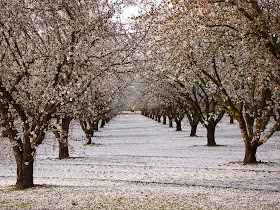 |
| Vernal swales on the summit area of Table Mountain. These have some similarity to vernal pools on the valley floor but are also different in some important respects. Click on this post for more info. |
 |
| Vernal swale on Table Mountain above Jamestown in the Sierra Nevada foothills |
There is very little of the original California prairie left, no more than five or ten percent. A lot of what is left has already been altered by grazing, but such lands are not getting particularly worse under that form of land use. It seems we hear that this new development or that one will only take only a few more acres, and a few more. Repeat over and over, and the last of the pools will be gone, especially if the politicians go through with their plans to restrict the power of the Environment Protection Agency and other government organizations to do their jobs and enforce the law.
 |
| Vernal pool east of Modesto |
 |
| So many trees, so little water to keep them alive. But profit is profit. |
From March 14, 2014: The Water Pirates: A Can a Day is All We Ask (plus 107 million gallons)
 |
| New orchard on the California prairie |
This could describe the effects of the California Gold Rush of the 1850s, but unfortunately it is not. It is a story that is happening right now in my neck of the woods (prairie?), and the worst of the destruction still lies ahead. And right now, there isn't a whole lot anyone can do to stop it. It's not gold, it's water. And despite the fact that gold is worth somewhere around $1,000 an ounce, the water is far more valuable.
Our local paper, the Modesto Bee, has been running a series of reports recently including this one by reporter J.N. Sbranti that should receive much wider exposure. Almonds have become a valuable and profitable commodity these days, and there is a wild rush on to plant as many acres of almonds as possible. In many cases farmers are simply switching from corn or other yearly crops and putting in orchards. The most destructive aspect, however is the planting of some 30,000 acres of almonds and other nut trees on the former prairie and grazing lands east of Modesto adjacent to the foothills of the Sierra Nevada.
The problem with the trees on the valley floor is that one can't let the fields lie fallow in the driest of years like the one we are now suffering through. The trees must be watered or they die, and they require 4 acre-feet of water per acre each year. If the water gets prohibitively expensive, so what? They'll have to pay the price.
 |
| California's version of "snow". The almonds are beautiful when they are blooming. |
What's worse are those almond orchards in the foothills. They can't be irrigated by normal means, as there is no infrastructure to deliver water there from the local irrigation district. The only source of water is from the ground, and there are few if any rules regarding the use of the groundwater. The large agribusinesses simply buy up the cheap grazing lands, put in the trees, and start pumping vast amounts of groundwater to water them. According to the Sbranti report in the Bee, the 30,000 acres of new orchards are consuming 39 billion gallons of groundwater each year, which is more than is currently pumped for domestic use across the entire county. The groundwater resource is limited, and will likely be depleted in the service of these orchards. When the water runs out, the orchards will die, but the owners will have gotten their cash. All legally of course, and damn the consequences.
It's all well and good to complain about government regulations, but theoretically government exists to watch over the well-being of the citizens. When there is no governance, the pirates take over, and we all lose. There oughta be a law, but I don't hear about anyone working on it. Much too arcane a political issue. At least until the wells run dry...
No comments:
Post a Comment